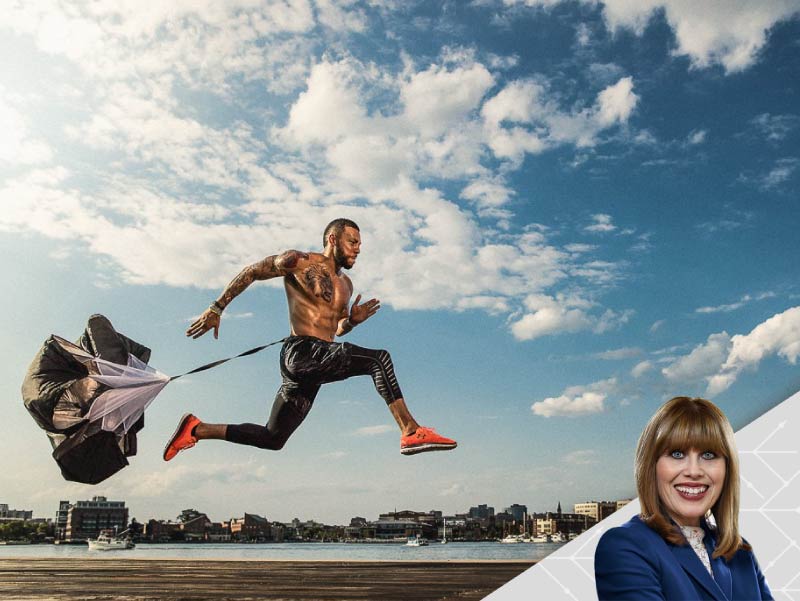Up, up and #UpAgainAfterStroke
By Nancy Brown, American Heart Association CEO

Everything you need to know about Rick Logan is embedded in the picture above.
Start with the parachute.
It's not there for support. Quite the opposite. As a fitness trainer, he uses it to generate resistance – to make workouts tougher. And it is. His pinched mouth reveals how hard he's pushing himself. The tightness around his eyes shows his determination.
Because he's shirtless, you see his chiseled torso. Notice the tattoo glistening on the right side of his chest. It's a lion in front of a clock; I'll explain the significance later.
The city he's soaring over is Baltimore. He's lived there since he was 14, save for a few key months.
The orange shoes are made by another Baltimore product, Under Armour. Rick has worked for the company as a fitness model and sponsored trainer.
The most revealing detail? The pants.
Rick wears them because he's sensitive to a lack of muscle in his legs. It's a byproduct of the stroke he suffered at 26.
Yes, this picture of health – this fitness model and trainer who seemingly leaps tall buildings – is a stroke survivor.
Today (Oct. 29) is World Stroke Day, a time to shine a light on the No. 2 killer in the world. This year's emphasis is on survivors and their recovery, a theme captured by the social media message #UpAgainAfterStroke.
The message is perhaps best expressed through the story of Rick Logan. Both of them.
***
Rick – formally, Richard Logan Jr. – grew up in Baltimore with his mom. His parents divorced and his dad lived in Huber Heights, Ohio.
The name was about all they shared. Until Richard Sr. suffered a stroke in 2010.
Rick was a sophomore at Towson University, just north of Baltimore. Although he wasn't close to his dad, Rick felt compelled to help, so he went to Huber Heights, a suburb of Dayton.
Richard was paralyzed on his right side. From his hospital bed, he and Rick talked for hours, forging the relationship Rick had always longed for.
Days turned to weeks. Richard began to recover and eventually went home. Rick stayed to help.
He returned to Towson for the fall semester. He was told that to continue receiving financial aid, he had to take a full slate of five classes plus the five he failed to complete.
Realizing the futility of trying to pass them all at once, Rick decided to pursue a passion stoked by all the conversations with his dad: fitness.
***
Richard Logan was into bodybuilding. Rick had dabbled in it, too.
Now Rick wanted to make a career out of it.
He became certified as a personal trainer. Soon he was also selling equipment. Then he became general manager of a gym. He envisioned himself running a company or his own gym.
One Saturday in 2016, Rick endured a series of headaches severe enough to awaken him. He had to get up early anyway for a 5 a.m. training session. Although he pushed his clients hard, Rick struggled to stand. Driving home was difficult.
He went back to sleep, but not for long. He called his then-girlfriend for a ride to an urgent care clinic. Having been with him the night before, she had to be convinced that he'd become so ill so quickly – that it was more than flu or food poisoning.
They'd been in the clinic's waiting room for about an hour when Rick's phone slipped from his left hand. Then again. When it happened a third time, his friend alerted the staff. Minutes later, a doctor was examining Rick.
Minutes after that, he was in an ambulance.
***
Rick's left side was paralyzed within two hours.
Tests showed his stroke was ischemic, meaning something blocked or reduced the blood flow to his brain. But they found no specific cause. This is considered a cryptogenic stroke. It happens in about 30 percent of ischemic strokes.
Frustrating as that was, the problem essentially cured itself. The paralysis eased. Four days later, Rick hobbled out of the hospital unsure the extent of the damage.
Alone in his apartment, he struggled to care for himself. He also struggled to grasp the notion that, like his dad, he was now a stroke survivor.
"The first month, I went to bed crying each night," he said. "It's hard to go to sleep if you don't know whether you're going to wake up."
Anti-depression medication helped spark him to recover.
He began working with a physical therapist for two different one-hour sessions per day. He put in another hour or two training himself. He viewed working out as a privilege, not a chore. He pushed himself to his limit, whatever that was.
"Sometimes it meant five pushups," he said. "I'd make the effort to go to the gym just to do that."
Nerve pain became his biggest foe, sometimes hitting so fiercely he couldn't get out of bed. He often couldn't control his left foot. A brown metal cane became a frequent companion.
His left hamstring tore. That had been his good one; he tore his right hamstring years before.
Leg workouts became too painful, the progress too minimal. So he gave them up.
That's why he always wears pants.
"It's a confidence thing for me," he said.
He sees people at the gym noticing the disparity in his muscle definition. Strangers occasionally say, "Did you skip leg day?" On days when the nerve pain flares and he uses the cane, the image of someone so strong showing weakness draws more stares and comments.
"Sometimes," he said, "I wish I could carry a sign that says, 'Hey, leave me alone, I've had a stroke.'"
***

The first name shared by the Logan men traces to King Richard I of England, who is remembered as Richard the Lionheart for being a noble warrior and leader.
In honor of that lineage and the renewed relationship with his dad, Rick designed a tattoo of a lion (symbolizing their fighting spirit) in front of a clock (representing the importance of appreciating their time together).
Rick recently had it added to his chest. He hopes to add it to Richard's chest next summer.
That's the target for two reasons.
First, Richard needs to get in better shape. He recently started a workout program customized by Rick. He's already dropped more than 20 pounds.
Second, Rick wants to give it to his dad as a birthday present. Both are born in July, five days apart.
They've started a tradition of traveling together around that time.
***
Rick recovered enough to resume being a personal trainer.
Then he stopped taking the anti-depression pills. He went into a funk, personally and professionally. He started drinking and lacked the motivation to exercise. Weight gain followed.
"I went to a really, really dark place," he said.
He scrolled through social media in search of posts that would inspire him to go to the gym. Recognizing his spiral, Rick challenged himself to become that inspiration – for himself and others.
He took a selfie that he was determined to be a "before" picture.
Him soaring over Baltimore is a compelling "after" image.
"It's great to put my story into words, but I also wanted a visual way to capture it," he said. "What I've learned most through my journey is that there's always a way to get it done. It may not be the road you've always traveled, but we can all get there."
A version of this column also appeared on Thrive Global.
If you have questions or comments about this story, please email [email protected].





